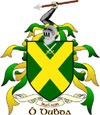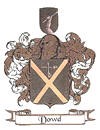O'Dowd (O'Dubhda) Dowd
The sept of O'Dubhda (pronounced O'Dooda) traces its descent from Fiachra, brother of Niall of the Nine Hostages, through Daithi, the last pagan King of Ireland. For centuries they were the leading sept of the northern Ui Fiachrach, a tribal group that occupied the modern counties of Mayo and Sligo.
Their territory at its widest embraced the baronies of Erris and Tirawley in Mayo and Tireragh in Sligo. They were traditionally inaugurated as princes of Ui Fiachrach at Carn Amhalghaigh near Killala. They were considerably reduced by the Anglo-Norman incursion into Connacht in the thirteenth century but were still powerful and in 1354 Sen-Bhrian O'Dowd succeeded in driving all the Anglo-Norman settlers out of Tireragh for a time.
The name has been well represented in its original homeland throughout the centuries up to the present day.
This is one of the "O" names with which the prefix has been widely retained, O'Dowd being more usual than Dowd. Other modern variants are O'Dowda and Dowds, with Doody and Duddy, found around Killarney, where a branch of the Connacht family settled.
All are O'Dubhda in Irish, the root word being "dubh" black. A quite distinct minor sept of O'Dubhda was located in County Derry. Survivors of this in Ulster today are usually called Duddy.
Several O'Dowds were bishops of the see of Killala. Father John O'Duada, who was tortured and hanged in 1579 was one of the many Irish Franciscan martyrs. Many of the name appear in the ranks of the Confederate Catholics and, later in the seventeenth century, in King James's army. The head of the sept at that time, who was killed at the battle of the Boyne, is said to have been seven feet tall, and it is noteworthy that great height is a feature of this family. In more recent times the best known is Rev. Patrick Dowd (1813-1891), the Irish priest who did so much for the Catholic community of Montreal.
HERALDRY

The Sept coat of arms of O'Dubhda are recorded by the Office of the Chief Herald of Ireland and also in Burke's General Armoury of England, Scotland, Ireland an Wales as:

Vert a saltire or, in chief two swords in saltire, points upward, the dexter surmounted of the sinister, argent pommells and hilts gold.
The record does not mention a crest, however, a grant of arms to Dowde or O'Dowde of Sligo, on 14 June 1608, confirms the shield and adds the following crest - an arm embowed, habited in mail, holding in the hand a spear all proper, headed argent.
Some more O'Dowd surname history
The O'Dowds of Hy-Fiachrach were one of the leading families in north Connaught from the ninth to the sixteenth century. Originally, their territory extended over much of the present County of Sligo and into Mayo, but, later, their possessions were confined to the barony of Tireragh. According to the 'Annals of Lecan', Hugh O'Dowd styled himself King of North Connaught.
His grandson, Mulrony, who died in 1005 had the title of Lord of Hyfiachrach. The O'Dowds were a maritime power of considerable ability in the twelfth and thirteenth centuries. On land they managed to hold their territory intact against the superior forces of the Burkes and Birminghams. The inaugural ceremony of each succeeding O'Dowd was presided over by a MacFirbis, the hereditary chroniclers of the clan.
The last election of an O'Dowd took place in 1595. Shortly afterwards, their power dwindled and they were eventually deprived of most of their patrimonial possessions. Daithi Og O'Dowd, who married in 1636, was the last generation of O'Dowds given by MacFirbis in his pedigree of the clan. One of the most celebrated of the chiefs of Hy-Fiachrach was Teige O'Dowd who succeeded as chief of his name in 1417. He founded the Abbey of Ardnarea and was patron of the MacFirbises whilst they were engaged in compiling the Books of Lecan.
A number of the clan have been bishops of Killala and the late John O'Dowd of Bunninadden was a worthy bearer of that ancient name. From 1900 until 1918 John O'Dowd was Nationalist Member of Parliament for Sligo and was chairman of Sligo County Council for a number of years. He was a ballad writer of note and contributed his compositions to the Sligo Champion and T.D. Sullivan's Weekly News. Gills of Dublin published a collection of his poems in 1888 under the title Lays of South Sligo.
ANOTHER DOWD MEMBER
O'Dowd : In the Battle of Ballinamuck the chains of the French Magazine were stolen by a man named Keegan. A circumstance that occurred after that Battle was the hanging of a Mayo gentleman named Captain O'Dowd, a member of this family. When on the cart (for a cart was the scaffold employed for the occasion), Duke Crofton, of Mohill Castle, a royalist, addressing O'Dowd, said: "You have brought yourself to a nice pitch. I believe you're a gentleman, and that your father keeps a pack" (of hounds). O'Dowd replied : "Yes, he keeps three packs, and his wippers-in are better gentlemen than you." Continuing, he said : "As I have to die, I shan't die like a trooper." His hands and arms were tied, yet he succeeded in removing his boots -- one foot assisting the other. "Now," he said "I am ready"!
...and don't mess with the female species of the family...
... the massacre that took place in Cloonlahard on 12 March 1580.
When Pelham in his pursuit of the earl of Desmond was encamped near Shanid castle, a man named Mac Shane approached him and said that he would lead him to the Cloonlahard woods, where over four hundred people had fled for safety. Mac Shane, who had been a gallowglass in Desmond’s army, was a man of repellent features and revolting habits.
He fell in love with a girl named O’Dowd, who refused to have anything to do with him. The O’Dowd’s were tenants of the Walls of Dunmoylan and lived at Balliston, a town land with an interesting history. They also sought refuge in Cloonlahard. When Pelham’s troops, led by Mac Shane, entered the wood they found the people clustered together, kneeling in prayer. When the slaughter began some of the young people fled and escaped.
One of these was Philip Geoghegan, the ancestor of Morgan whom I have already mentioned. Philip’s sister, who was married to Hugh Cummane, climbed an ivy-clad tree and escaped detection. She witnessed the merciless slaughter of her friends and relatives, which was all over in a short time.
Only one person’s life was spared. That was the O’Dowd girl, whom Mac Shane had taken prisoner. Pelham’s troops soon vacated the woods and pushed on towards Glin. Mac Shane returned a little later, accompanied by his prisoner, and began to search the clothes of the dead. While doing so he laid aside his battle-axe.
As he was bending down his prisoner seized the weapon and with one swift blow she clove his skull. She later married Dermot Dore, who also escaped from the carnage. She became a legendary figure and many people in that locality were proud to claim descent from her.
The following is drawn from an information package received from the Irish Heritage Research
An outline of the O'Dubhda Family History
The Uí Faichrach -- early origins
There are many people of Irish descent who can justly claim an ancestry as ancient and royal as that of any of the famous European dynasties. Among them are the O'Dubhda family (pronounced "O'Dooda"), including the O'Dowda, O'Dowd and other variant spellings, who are descended (with many other families) from a people in the West of Ireland once known as the Uí Faichrach ("Ee Fee-a-crock"). This name derived from a 5th century pagan king of Connacht called Fiachra ("Fee-a-cra"). His grandson Daithi ("Daw-hee") also became king and was killed by lightning about 445 A.D. His grandson Aillil ("Al-ill") succeeded as King of Connacht and later King of Tara until 482.
The O'Dubhda surname
The Uí Faichrach provided successive kings of Connacht for a long period, but their sphere of influence became confined to North Connacht. In the late 10th century, their king was named Aedh Ua Dubhda i.e. Hugh, the grandson of Dubhda ("Dooda"). He was king of an area roughly corresponding to the two counties of Mayo and Sligo. He is recorded as having 'died an untroubled death' in the year 982, making this surname one of the oldest in Europe. As the use of surnames became more widespread, descendants continued to use the name O'Dubhda to distinguish their own royal family. This is pronounced "O'Dooda", but there are as many as forty different variations on the surname.
The O'Dubhda Taoiseach
The O'Dubhda remained kings of North Connacht until the 13th century. However, great changes took place in Irish society and they lost control over much of their former lands before being confined to the barony of Tireragh ("Tea-rare-ra") meaning 'the country of Fiachra' in Co. Sligo. As a result, they gradually dropped the use of the title king. This was replaced in time by the title Taoiseach ("Tea-shock"), i.e. chieftain or leader. This term is now used as the title of the Irish Prime Minister. The man who became Taoiseach was generally referred to by his surname only, e.g. O'Dubhda. In this way he came to be referred to as chief of his name. He was elected according to the old Irish laws and sometimes there was dispute over the leadership. One means of avoiding conflict was by the selection of a Taoiseach-elect, called a Tanaiste ("Thaw-nishta"). This term is now used for the Irish Deputy Prime Minister. The election and inauguration was presided over by the ollamh ("Ulav") or professor of the Mac Firbis family of scholars.
The O'Dubhda is unique in having a detailed account of the inauguration ceremony of their Taoiseach preserved in an ancient manuscript of the Mac Firbis scholars. This manuscript, known as the Great Book of Lecan, was written near Enniscrone in Tireragh between 1397 and 1418 and is now carefully preserved as one of our Irisn national treasures in Dublin. One of the most generous sponsors of the Mac Firbis scholars was Tadhg Riabhach O'Dunhda ('Dark Teige'), who became Taoiseach of Tireragh in 1417. He is particularly remembered in this manuscript where his death is recorded at Enniscrone Castle. This unique treasure preserves much of our ancient Irish heritage. It contains information relating to the history of hundreds of different Irish families. Both the Mac Firbis bardic scholars, who wrote it, and the O'Dubhda rulers who supported them, deserve our rememberance.
O'Dowda and O'Dowd, Dowd and Doody, etc.
The ancient laws of Ireland, known as the Brehon Laws, continued in use until the early 1600s. The last Taoiseach to be elected under these was Tadhg Buí O'Dubhda ('Blonde Teige'). He was inaugurated in 1595, and led his army south to the battle of Kinsale in 1601. He never came back. Tradition states that he survived the battle and settled in Co. Kerry, where his family later became known as Doody. During the 17th century, the rest of the O'Dubhda ruling family was displaced from their homeland, where they had owned 24 castles and 52 towns, including Enniscrone. They split into two main branches, and these settled in Co. Mayo. In dealings with government officials using the English language several different spellings of the surname were introduced, one branch using the spelling of O'Dowda, while the other branch became known as O'Dowd. Two centuries earlier a third branch had left and settled near Dublin, where they became known as Dowd. Although there are more than 40 other variations, Dowd and O'Dowd are now the most common versions of the surname. There are many descendants now loving who can trace their ancestry directly back to the original O'Dubhda kings.